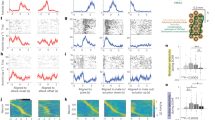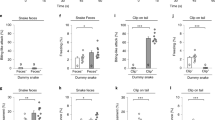Abstract
IT has been pointed out that much of the literature on brain mechanisms of aggression fails to distinguish between different kinds of aggressive behaviour, and that this may account for some of the apparent contradictions in different publications1. In the experiments reported here the effects of hypothalamic lesions were measured on two different types of aggressive behaviour: defence behaviour, which consists of a defensive upright posture and boxing in the shock box; and territorial behaviour, which consists of the offensive side posture and the full attack posture with biting and kicking by a socially isolated home rat against an intruder. These postures associated with social interactions are quite stereotyped in the rat. They are also present in modified form in other rodents and have been illustrated and catalogued previously2.
This is a preview of subscription content, access via your institution
Access options
Subscribe to this journal
Receive 51 print issues and online access
$199.00 per year
only $3.90 per issue
Buy this article
- Purchase on Springer Link
- Instant access to full article PDF
Prices may be subject to local taxes which are calculated during checkout
Similar content being viewed by others
References
Moyer, K., Comm. Behav. Biol., 2, 65 (1968).
Grant, E., and Mackintosh, J., Behaviour, 21, 246 (1963); Barnett, S., in The Rat: A Study in Behaviour, 81 (1963).
Author information
Authors and Affiliations
Rights and permissions
About this article
Cite this article
ADAMS, D. Defence and Territorial Behaviour dissociated by Hypothalamic Lesions in the Rat. Nature 232, 573–574 (1971). https://doi.org/10.1038/232573a0
Received:
Revised:
Issue Date:
DOI: https://doi.org/10.1038/232573a0
This article is cited by
-
Imaging the neural circuitry and chemical control of aggressive motivation
BMC Neuroscience (2008)
Comments
By submitting a comment you agree to abide by our Terms and Community Guidelines. If you find something abusive or that does not comply with our terms or guidelines please flag it as inappropriate.



